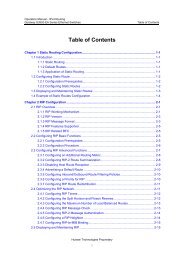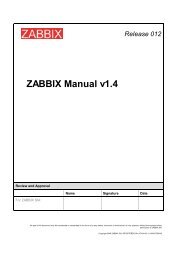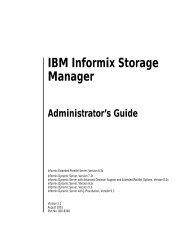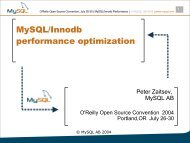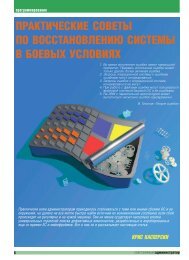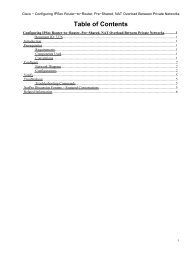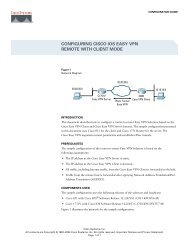Solaris Application Programming, 1/e - Chapter 4 - Parent Directory
Solaris Application Programming, 1/e - Chapter 4 - Parent Directory
Solaris Application Programming, 1/e - Chapter 4 - Parent Directory
You also want an ePaper? Increase the reach of your titles
YUMPU automatically turns print PDFs into web optimized ePapers that Google loves.
4.4 PROCESS- AND PROCESSOR-SPECIFIC TOOLS 83<br />
Example 4.47 Number and Size of Calls to malloc by ls (continued )<br />
256 |@@@@@ 2<br />
512 | 0<br />
1024 | 0<br />
2048 | 0<br />
4096 | 0<br />
8192 | 0<br />
16384 | 0<br />
32768 |@@@ 1<br />
65536 | 0<br />
Once the sizes of the memory requests have been determined, it may also be<br />
interesting to find out where the memory requests are being made. The script<br />
shown in Example 4.48 captures the call stack for the calls to malloc.<br />
Example 4.48 Capturing the User Call Stack for Calls to malloc<br />
#!/usr/sbin/dtrace -s<br />
pid$target:libc.so:malloc:entry<br />
{<br />
@stack[ustack(5)]=count();<br />
@array[probefunc]=quantize(arg0);<br />
}<br />
END<br />
{<br />
printa(@stack);<br />
printa(@array);<br />
}<br />
An example of running the script to capture the call stack of calls to malloc is<br />
shown in Example 4.49.<br />
Example 4.49 Call Stack for malloc Requests Made by the Compiler<br />
# ./malloc_stack.d -c "cc -O an.c"<br />
dtrace: script './malloc_stack.d' matched 2 probes<br />
dtrace: pid 4063 has exited<br />
CPU ID FUNCTION:NAME<br />
6 2 :END<br />
...<br />
cc`malloc<br />
libc.so.1`calloc+0x58<br />
cc`stralloc+0x8<br />
cc`str_newcopy+0xc<br />
cc`addopt+0x88<br />
154<br />
continues




